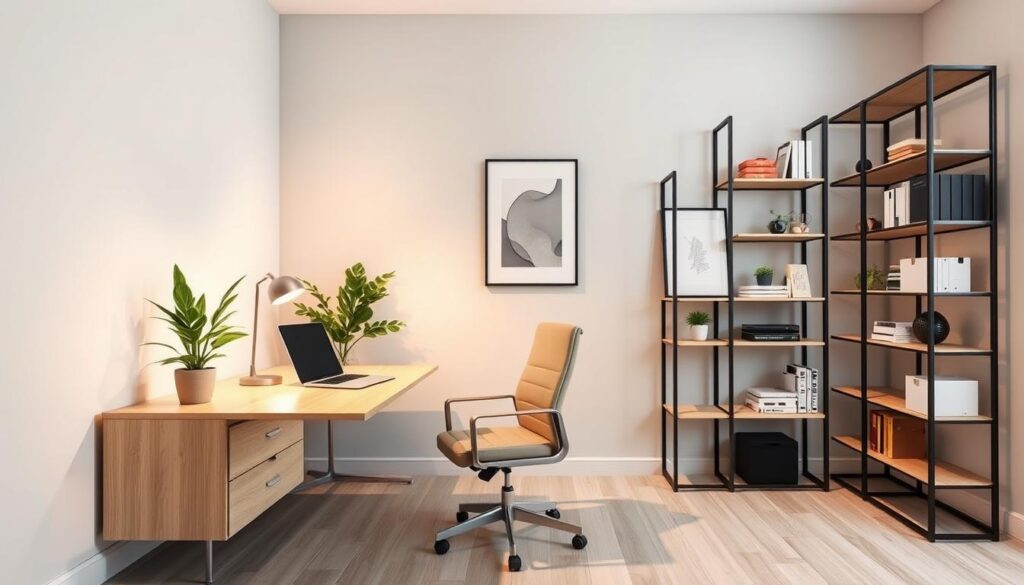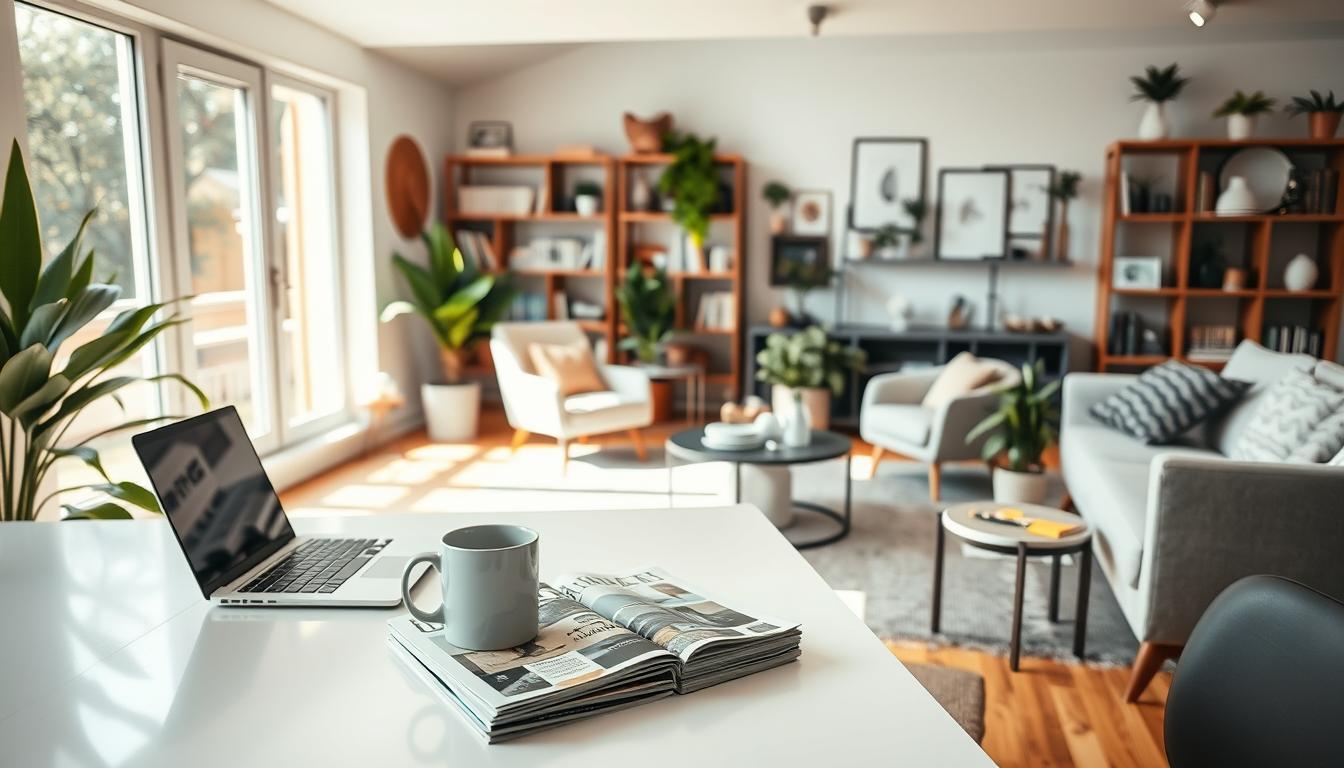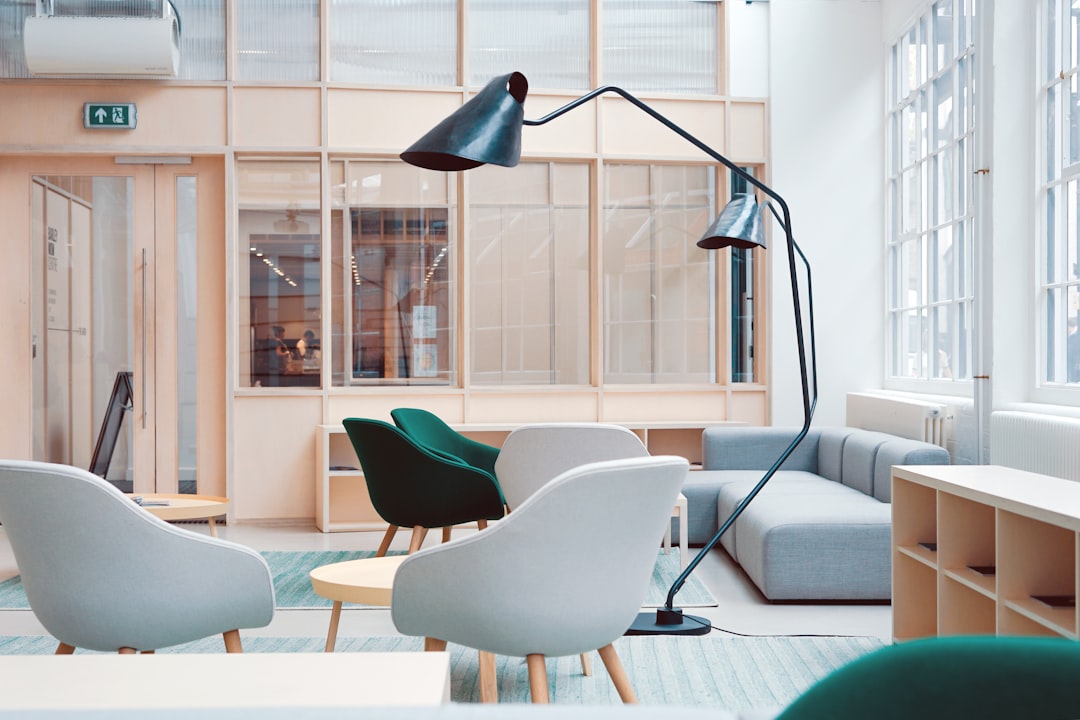The need for skilled interior designers is growing fast. The Bureau of Labor Statistics says there will be a 5% increase in jobs from 2020 to 2030. It’s key for new designers to know what interior design jobs are out there.
We’ll show you the different design jobs, what you need to qualify, and how to find your perfect job. This guide is for both new and experienced designers. It aims to give you the info and tips to thrive in design.
Key Takeaways
- Types of design jobs available
- Qualifications required for interior design jobs
- Tips for finding and landing your dream job
- Industry trends and growth prospects
- Resources for aspiring designers
Why Pursue a Career in Interior Design?
Interior design is more than just decorating. It’s about creating spaces that make people’s lives better. This makes it a rewarding career. We’ll look at why it’s a good choice, including creative growth, job market trends, and personal fulfillment.
Creative Growth and Opportunity
Interior design offers endless chances for creativity and growth. Designers work on various projects, from homes to commercial spaces. Each project brings new challenges and learning opportunities.
Key areas of creative growth include:
- Understanding client needs and preferences
- Staying updated with the latest design trends and technologies
- Experimenting with different materials and spatial configurations
Job Market Trends
The demand for interior designers is growing. This is because people want sustainable and functional spaces. The Bureau of Labor Statistics says interior designer jobs will grow 5% by 2030.
| Industry | Growth Rate | Median Salary |
|---|---|---|
| Residential Design | 4% | $55,000 |
| Commercial Design | 6% | $65,000 |
| Sustainable Design | 8% | $70,000 |
Personal Fulfillment
Interior design can be very fulfilling. It lets designers create spaces that improve people’s lives. Seeing their ideas come to life is rewarding.
“The best interior designers are not just decorators; they are problem solvers who create functional and beautiful spaces.”
Exploring interior design careers shows it’s more than a job. It offers creative growth, a strong job market, and personal fulfillment. So, a career in interior design is definitely worth considering.
Types of Interior Design Jobs Available
Interior design offers many roles for different talents and dreams. It’s not just about designing spaces. It also includes various specialties that need different skills and interests.
Residential Designer
Residential designers make homes look good and work well. They talk to homeowners to get what they want. They need to listen well and pay attention to details.
Key Responsibilities: They plan out spaces, pick colors and materials, and make sure everything is installed right.
Commercial Designer
Commercial designers make spaces for businesses look good and work well. They design offices, restaurants, and stores. They must know about branding and how to make customers happy.
Essential Skills: They need to know about building codes, green practices, and handling big projects.
Set Designer
Set designers create sets for movies, TV, and theater. They must be creative and understand scripts and directors’ ideas. They turn these ideas into real spaces.
Key Skills: They should know design software, lighting, and camera angles. They also need to work fast.
Furniture Designer
Furniture designers make pieces that are both useful and pretty. They work with makers to sell their designs. They must keep up with design trends and new materials.
Important Traits: They need to be creative, know about making things, and balance looks and use.
These jobs show how varied interior design is. They offer many ways for people to follow their dreams and succeed in in-person interior design careers or nearby interior design employment.
Qualifications Required for Interior Design Careers
To succeed in interior design, you need education, certifications, and key skills. Knowing what sets you apart is crucial in this competitive field.
Educational Background
Most interior designers have a degree in interior design or a similar field. The resources available show that education lays a solid foundation. It covers design principles, space planning, and color theory.
Classes also focus on building codes, accessibility, and sustainable design. This knowledge is vital for any designer.
Relevant Certifications
While a degree is key, certifications can boost your career. The NCIDQ (National Council for Interior Design Qualification) is highly respected. To get certified, designers must pass a tough exam.
For those wanting to start their own business, learning how to succeed is crucial. Understanding the steps to establish a successful interior design business is valuable.
Essential Skills and Traits
Interior designers need technical skills, creativity, and good communication. They must be proficient in CAD software and know building codes. Creativity helps in creating innovative designs that meet client needs.
Strong communication skills are also vital. They help designers work well with clients and other professionals.
By focusing on education, certifications, and skills, you can excel in interior design. You’ll be ready to find interior design jobs near me or explore interior design job openings in my area with confidence.
How to Find Interior Design Jobs Near You
If you’re searching for interior design jobs near you, there are several ways to improve your search. Using a mix of online tools, networking, and local events can help you find a job.
First, it’s important to know where to look for local interior design job opportunities. Online resources, professional networks, and local events are key. They can greatly increase your job search success.
Online Job Boards and Websites
Online job boards and websites are great for finding nearby interior design employment. Sites like Indeed, LinkedIn, and Glassdoor let you search by location. This makes it easier to find jobs close to you.
There are also job boards focused on design and creative fields. Behance and Dribbble are excellent for interior design job searches.
Networking and Professional Associations
Networking is a strong tool in any job search. For interior designers, joining groups like the American Society of Interior Designers (ASID) is beneficial. It offers job listings, networking chances, and professional growth opportunities.
Going to industry events, seminars, and workshops is also beneficial. It keeps you updated on trends and lets you meet potential employers and peers.
Local Design Events and Workshops
Local design events and workshops are another good way to find local interior design job opportunities. These can include design exhibitions, hands-on workshops, and masterclasses.
Getting involved in the local design scene helps you meet other designers, potential clients, and employers. This can open up job opportunities.
In summary, finding interior design jobs near you needs a strategic plan. Use online job boards, network, and attend local design events. These steps can boost your chances in the competitive interior design job market.
Tips for Crafting a Standout Interior Design Resume
In the competitive world of interior design, a well-crafted resume can make all the difference. When applying for interior design positions nearby, it’s crucial that your resume stands out from the crowd.
To create a compelling resume, you need to highlight your relevant experience, showcase your portfolio effectively, and tailor your application to the specific job you’re applying for. Let’s dive into the details.
Including Relevant Experience
Your experience is a key factor in securing in-person interior design careers. List your previous roles in reverse chronological order, focusing on achievements rather than just responsibilities.
- Highlight specific projects you’ve worked on, including the challenges you faced and how you overcame them.
- Mention any successful collaborations with clients or other designers.
- Include any relevant software or tools you’ve mastered, such as AutoCAD or SketchUp.
Showcasing Your Portfolio
Your portfolio is a visual representation of your skills and creativity. Make sure it’s up-to-date and showcases your best work.
Include a variety of projects that demonstrate your versatility as an interior designer. For each project, provide context about your role and the outcome.
Tailoring Your Application
Customizing your resume for each job application is vital. Use keywords from the job posting to describe your skills and experience.
For example, if the job posting emphasizes “sustainable design practices,” make sure you highlight your experience in this area. This will help your resume pass through applicant tracking systems (ATS) and catch the eye of the hiring manager.
By following these tips, you can create a standout resume that increases your chances of landing an interview for your desired interior design positions nearby.
Preparing for Interior Design Job Interviews
Getting ready for an interior design job interview can feel overwhelming. But, with the right strategy, you can nail it. As you look for interior design jobs near you, make sure you’re ready for the interview.
First, learn about the company you’re interviewing with. Understand their design approach and ongoing projects. This will help you tailor your answers and show your genuine interest in the role.
Common Interview Questions
Interviews often include a mix of questions. Here are some you might face:
- What inspired you to become an interior designer?
- Can you describe your design style?
- How do you handle challenging clients?
Think about how you’ll answer these questions. Your goal is to show off your skills and experience.
How to Present Your Work
Your portfolio is key during an interview. It should be organized and highlight your best work. Here are some tips:
- Include a variety of projects to show your versatility.
- Use high-quality images and clear descriptions.
- Be ready to talk about your design choices and process.
Dos and Don’ts During Interviews
To leave a good impression, follow these tips:
| DO | DON’T |
|---|---|
| Be on time and dress professionally. | Don’t be late or underdressed. |
| Bring multiple copies of your resume and portfolio. | Don’t forget to leave a copy of your resume or portfolio. |
| Show enthusiasm and interest in the company. | Don’t appear disinterested or unenthusiastic. |
By following these guidelines and preparing well, you’ll be set to ace your interior design job interview. You’ll be one step closer to getting the job you want.
Salary Expectations for Interior Design Positions
The money you can make in interior design changes a lot. When looking at interior design jobs near me or local interior design job opportunities, knowing what affects pay is key. This knowledge helps you make better choices.
Factors Affecting Salary
Many things can change how much an interior designer makes. These include:
- Where you live
- How long you’ve been working
- The type of projects you do (homes, offices, etc.)
- Your education and any special certifications
- The size and type of company you work for
These factors really shape what interior designers earn. For example, those in big cities or working with fancy clients might earn more. This is compared to those in smaller places or with tighter budgets.
Industry Averages in the United States
The Bureau of Labor Statistics says interior designers in the U.S. make about $60,000 a year on average. But, salaries can go from about $35,000 for newbies to over $100,000 for top designers or those with special skills.
| Experience Level | Average Salary Range |
|---|---|
| Entry-Level (0-3 years) | $35,000 – $50,000 |
| Mid-Level (4-7 years) | $50,000 – $75,000 |
| Senior (8+ years) | $75,000 – $100,000+ |
Entry-Level vs. Experienced Roles
Being new or experienced in interior design isn’t just about money. It’s also about the projects you get to do, how much responsibility you have, and who you work with. More experienced designers often lead projects, teach others, and can ask for higher pay because of their value.

When you’re looking at local interior design job opportunities, knowing these differences helps. It lets you aim for success and get a salary that matches your abilities and experience.
The Impact of Location on Interior Design Jobs
Where you live greatly affects the interior design jobs you can find. The type of area you’re in, like city, town, or countryside, shapes the demand for certain design services.
Urban vs. Rural Opportunities
Big cities like New York, Los Angeles, and Chicago have lots of interior design jobs. They need designers for both homes and businesses. But, small towns and rural areas have fewer jobs. They mostly need designers for homes.
Urban Opportunities: More commercial projects, higher demand for luxury designs, and a diverse client base.
Rural Opportunities: More residential projects, a focus on practicality and local aesthetics, and a closer-knit community.
Hotspots for Interior Design Careers
Some cities in the U.S. are hotspots for interior design. These places offer many job chances. They are known for their culture and architecture.
- New York City: Known for its luxury interior design and high-end residential projects.
- Los Angeles: Famous for its glamorous and modern interior designs, often featured in films and media.
- Miami: A hub for contemporary and tropical interior design styles, with a strong influence from its diverse cultural background.
Remote Job Options
Remote work has changed the interior design field. Designers can now work with clients worldwide. This is thanks to digital tools and platforms.
| Benefits | Challenges |
|---|---|
| Flexibility and work-life balance | Difficulty in communicating design concepts without in-person meetings |
| Access to a global client base | The need for robust digital skills and familiarity with design software |
| Reduced commuting time and expenses | Potential isolation and lack of face-to-face interaction |
As the interior design world grows, knowing how location affects jobs is key. It helps designers plan their careers.
Building a Successful Career in Interior Design
A successful interior design career needs ongoing learning, mentorship, and staying current with trends. The field keeps changing, so designers must keep up to stay competitive. This is especially true when looking for interior design positions nearby or interior design job openings in my area.
Continuing Education and Training
Keeping up with education is key in interior design. It helps designers learn new skills and stay updated with industry standards and tech. Workshops, seminars, and online courses can help.
For example, learning about green design or new software can boost a designer’s portfolio. This makes them more attractive to employers.
Aspiring designers should look for specialized training. Reputable design schools offer such programs. They provide a strong base and prepare designers for the industry’s demands.
Seeking Mentorship
Having an experienced mentor is very beneficial for designers. A mentor can guide, share insights, and give feedback on work. This is especially helpful when looking for jobs or specific opportunities.
To find a mentor, designers can go to industry events, join associations, or use online platforms. A strong network can lead to mentorship and new career chances.
Staying Updated with Trends
Knowing the latest design trends is essential for creating appealing designs. Designers should follow leaders, read publications, and attend trade shows. This way, they can stay inspired and informed about what’s in demand.
Being trend-aware also helps designers prepare for future changes. They can adjust their skills and portfolios. This proactive approach is crucial when applying for interior design job openings in a competitive market.
Work-Life Balance in Interior Design Roles
As interior designers, finding a balance between work and personal life is key. When looking for jobs, think about how a role will affect your balance. This is important for your well-being.
Time Management Strategies
Good time management helps keep a balance. We can sort tasks, set deadlines, and avoid distractions. This way, we meet client needs without losing personal time.
Navigating Client Expectations
Strong client relationships are crucial in interior design. We must talk clearly, set limits, and manage what clients expect. This keeps our work relationship positive and productive.
Fostering Personal Creativity
To stay creative and motivated, we need to care for our creativity. This means exploring new trends, going to design events, or just taking breaks. It helps us stay inspired.
By focusing on these areas, we can have a rewarding career in interior design. We can do this while keeping a healthy balance between work and life. This is true whether we’re working on local projects or looking for new jobs.



